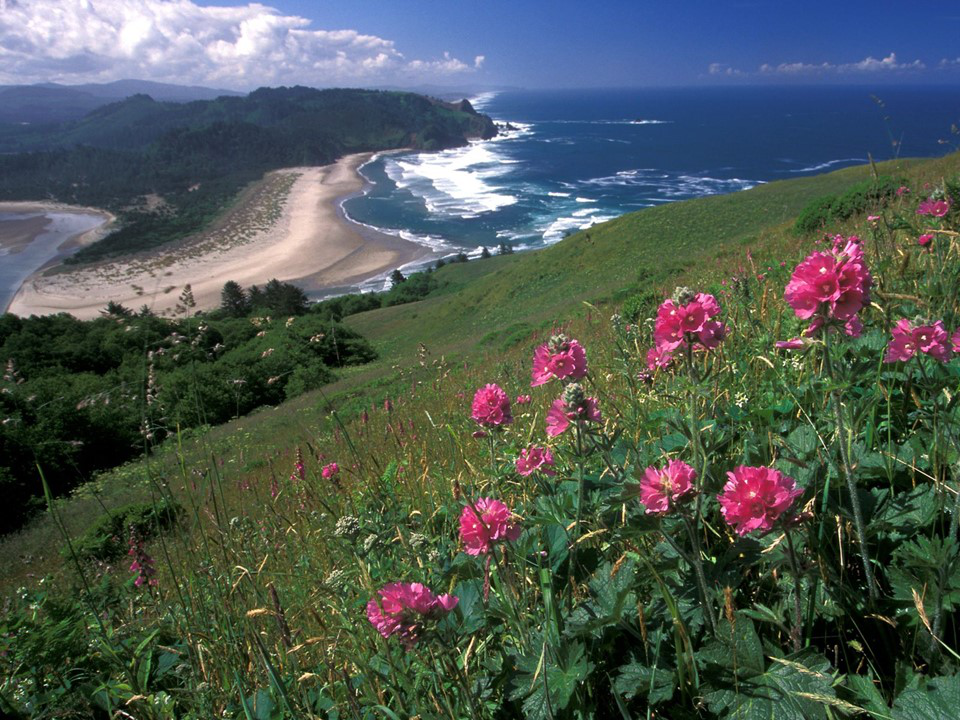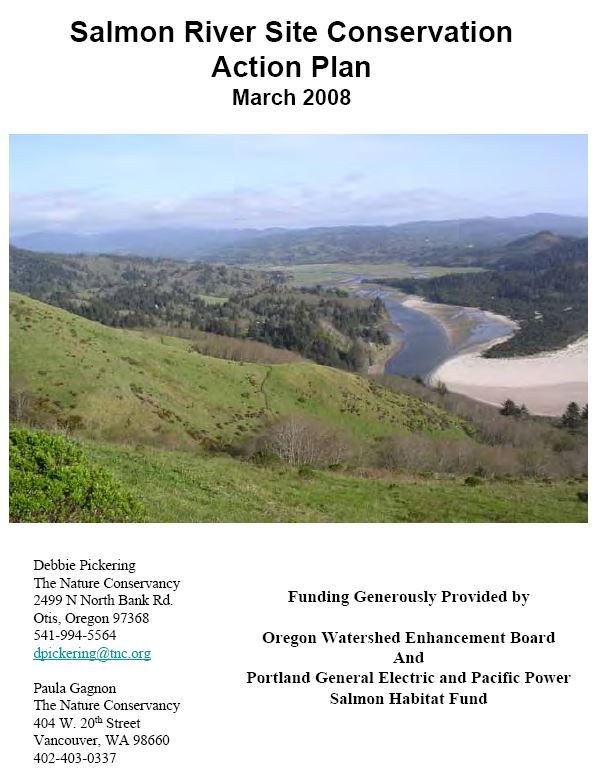Rooted in The Nature Conservancy’s (TNC) Cascade Head Preserve, this case study features adaptive management using ground based research for the Oregon silverspot butterfly, that later grew to encompass diverse stakeholders for conservation management of the Salmon River watershed. See the Miradi share file here, and the detailed account of the case study here.
Background
Natural areas managers often work in degraded systems and face uncertainty about how to restore them. Imperiled species require immediate actions for improving habitats even when ideal techniques are unknown.
Additionally, individual natural areas are surrounded by a diversity of land uses and ownerships that can have consequences for management of the natural area. This case study shows how adaptive management addresses this dilemma.
The Salmon River watershed encompasses 75 square miles (approximately 50,000 acres) in Oregon, NW USA, empties into the Pacific Ocean in protected areas, but upstream, the watershed is dominated by dense rural residential and small commercial developments, plus private industrial timberland.

Cascade Head Preserve at the mouth of the Salmon River estuary. Steep, south-facing slopes harbor remnant coastal prairie and several endemic species, including the threatened Oregon silverspot butterfly. Photo Credit: The Nature Conservancy.
Adaptive management for the Oregon silverspot butterfly
The Oregon silverspot butterfly, the focus of much of The Nature Conservancy’s activity at Cascade Head, used to occur in coastal grasslands from southern Washington to northern California, but now four populations remain, including the one at Cascade Head and now severely at risk.
Silverspot larvae feed almost exclusively on Viola adunca, the western blue violet, an early successional species that requires disturbance to prosper. Conceptual models of their ecological requirements identified altered fire regimes and invasive non-native plants as key threats.
Field experiments from 1994 to 1999 to compared two management options: fall burning and fall mowing followed by raking, with an unmanaged control to test the response of butterfly resources (nectar and food plants) and the overall plant community, especially invasive non-natives. This showed that a single fall burn of non-native grassland maintained the existing degraded community rather than restoring its native composition, but did have a positive effect on the violets.
As a consequence, management-scale burns were introduced in 1998, along with further research into timing and intensity of burns, plus active restoration methods to tip the balance more towards the favoured native plant species.
Despite these management changes, though, the silverspot’s population crashed in 1993 and again in 1998 and the outlook remained bleak. Captive breeding commenced in 2002 and releases continued through 2012. Monitoring after the cessation of captive release indicated that this approach did not yield a permanent, but only a temporary population increase. The population remain imperiled and research continues.

Salmon River Conservation Action Plan
Salmon River Watershed CAP
Recognising the Salmon River area as an important place for the conservation of biodiversity in the Pacific Northwest Coast Ecoregion, TNC brought together a diverse group of stakeholders in 2006 who used the Open Standards to develop the Salmon River Conservation Action Plan.
Participants in the process included community members, representatives of state and federal agencies, timber companies, conservation organizations, private landowners, scientists and academics. Over the course of seven months (December 2006 – July 2007), participants compiled information and data to profile the current condition of the area, defined the desired conditions that stakeholders envision for the basin and nearby ocean environments, and identified concrete steps that citizens, conservation organizations and conservation partners can take to realize that vision.
Learnings
We showed that active adaptive management can advance our understanding even at a small site with a modest budget and limited staff. Whilst we have not recovered the butterfly at Cascade Head, we eliminated some ineffective management actions. Without adequate monitoring to provide information about how key components of the habitat were responding, the site could lose the components of native grassland, including violets, through the increasing density of invasive plants or lose nectar sources due to incompatible mowing practices. Alternatively, we might have delayed implementing ANY management until we had conclusive research results showing us what our management should be. That approach can result in loss of habitat that is already declining in quality.
We found collaboration with key partners to be an effective way to stretch our resources to accomplish this work. Building teams of scientists and land managers through partnerships with local universities, NGOs, and natural resource agencies can increase the capacity of managers on a shoestring budget to do effective adaptive management. Using the Open Standards planning methods provides a compelling approach for bringing diverse stakeholders to the table and getting all land managers in an area on the same page and working towards shared goals using coordinated strategies. Rooted in TNC’s Cascade Head Preserve, this case study features adaptive management using ground based research for the Oregon silverspot butterfly, that later grew to encompass diverse stakeholders for conservation management of the Salmon River watershed. See the Miradi share file here, and the detailed account of the case study here.
Background
Natural areas managers often work in degraded systems and face uncertainty about how to restore them. Imperiled species require immediate actions for improving habitats even when ideal techniques are unknown.
Additionally, individual natural areas are surrounded by a diversity of land uses and ownerships that can have consequences for management of the natural area. This case study shows how adaptive management addresses this dilemma.
The Salmon River watershed encompasses 75 square miles (approximately 50,000 acres) in Oregon, NW USA, empties into the Pacific Ocean in protected areas, but upstream, the watershed is dominated by dense rural residential and small commercial developments, plus private industrial timberland.
